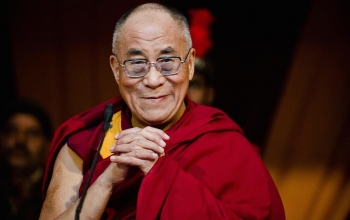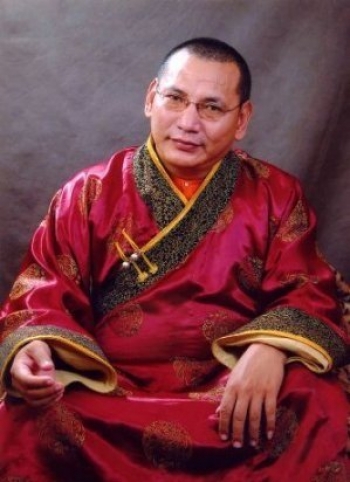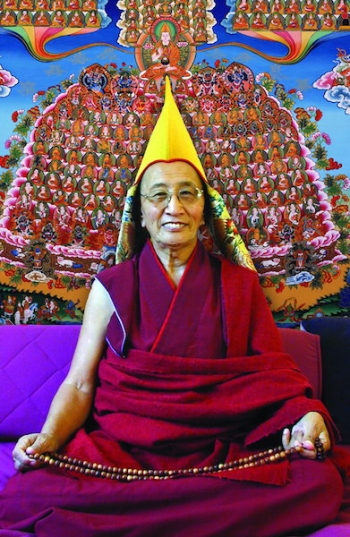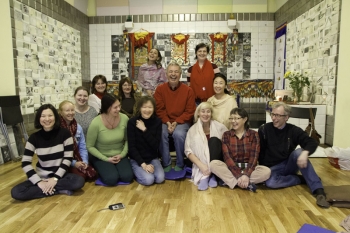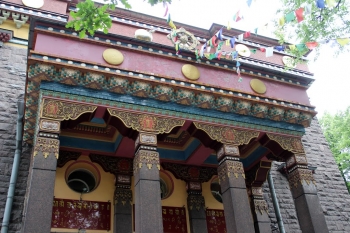The year was 1993, shortly after the collapse of the Soviet Union. Two years had passed since the heroic city of Leningrad was rechristened Saint Petersburg, its imperial name. Vasily Repin was a student at the Polytechnic University when he discovered that all courses on the history of the Communist Party had abruptly been cancelled. Instead, free electives in the humanities were now on offer, and he remembers choosing a course on the history and culture of religion.
“There I learned about basic Buddhist concepts and met one of my classmates, who introduced me to the temple in Saint Petersburg,” says Vasily, who currently works as an engineer. “That same year, I attended a Buddhist lecture by Geshe Jampa Tinley [spiritual director of the Lama Tsongkhapa Buddhist Center in Moscow and spiritual representative of the Dalai Lama in Russia], who was visiting our city for a short period of time. He was the first Buddhist teacher I ever saw. Again in that year, I formally took Refuge.”
Looking back, the final decade of the 20th century had presented an opportunity for him and many other Russians to explore once-shunned religions—and if they so desired, to convert to them. A member and former director of Aryadeva Buddhist Center, he formally follows the Gelug school of Tibetan Buddhism, although he draws inspiration from others like the Drikung Kagyu. Aryadeva, founded by a lady called Magarita Kozhevnikova, is one of the few dedicated sanghas in the city, hosting a close-knit community of Gelugpa Russians. It rents an unassuming room in the basement of the Saint Petersburg temple, which is a magnificent structure combining Russian architecture with Vajrayana aesthetics.
Writer and poet Vladimir Shehov, who was born in 1963, is most inspired by Zen, which is not as popular as the Tibetan traditions in the urban centers of Moscow and Saint Petersburg. Having lived most of his life in the ancient city of Nizhny Novgorod, he discovered Buddhism as a physics student. Buddhism in the Soviet period, he claims, was presented in a completely unattractive way. “Buddhism was accused of assuming all life to be continuous suffering. State ideology insisted that in the USSR, there were no problems and no suffering. There was merely continuous happiness, thanks to the citizens’ participation in the Stalinist vision of society,” he tells me. At the same time, Zen became fashionable despite being completely misunderstood thanks to a lack of good literature and translations. It was thought to be a method of expanding consciousness and a way of obtaining mental skills, but was never properly contextualized as a school of a religion with a worldview quite different to that which the Slavic heritage was used to.
To this day, Vladimir practices alone along the lines of Soto shikantaza (“just sitting”), including meditating in the morning and evening. “I have really changed,” he replies when I ask him whether he feels he has benefited from practice. “My aggression has almost all gone, and I am much gentler in my relations with people. I understand that they are in need of compassion.”
The narrative of self-exploration and the inner journey will be familiar to those who have read about the early disseminators of Buddhism in the West like Alan Watts or Gary Snyder. The hippie generation existed during a period of unequaled geopolitical tension, and Venerable Tenzin Tsokyi’s story reads like she could have been a traveling seeker from the United States. Originally named Helena, she was born in Russia but hasn’t returned for two years, instead opting to live in Dharamsala. She feels the environment there is more conducive to studying Buddhism.
“Earlier, I was a Hindu nun, and when I returned to Russia from the Philippines, where I was teaching meditation and Hatha Yoga, I left monasticism and started to search for my spiritual way further. So I became interested in Buddhism, and then, I met Margarita Kozhevnikova and her husband, Dr. Andrey Terentyev [the editor of the Buddhism in Russia website]. I started to help out in her center Aryadeva, and there met my first teacher, Kirti Tsenshab Rinpoche [1926–2006],” she says. Kirti Tsenshab Rinpoche was a teacher of Lama Zopa Rinpoche and a lineage holder of the Kalachakra tantra.
Kirti Tsenshab Rinpoche was also the teacher of Ivan Ivanin, a successful lawyer. He also goes to Aryadeva. “I practice the Lamrim [Graduated Path] and Guru Yoga [merging one’s wisdom mind with that of the teacher],” he says. “I constantly contemplate impermanence, as my teacher advises. This helps me a lot.” Authenticity is a perennial concern for Russian Buddhists, and the physical locations of Buddhist masters seem to matter. There has been relatively little coverage—and little presence—of non-resident Vajrayana teachers in the circles of Saint Petersburg, let alone amongst the majority-Buddhist Kalmyk, Tuvan, and Buryat minorities.
One possible reason is that it simply isn’t easy to encounter teachers here. “I consider the Dalai Lama to be my teacher,” says Vasily Repin. “All other teachers are equally important to me. I don’t have my own teacher in Russia. But I consider Andrey and Margarita as my oldest spiritual friends. I think it is very difficult to meet a real teacher in Russia.”
Ven. Tenzin Tsokyi agrees. “In Russia, it is possible to meet your teacher, but only to meet. Nowadays there are many Tibetan teachers who come to give initiations and teach Dharma, for example in Moscow or Saint Petersburg, but then they go away and you can never see them again. It is important to be very attentive and not to hurry to accept every Tibetan lama as a teacher,” she warns.
“It is useful to study, for example, in the Lamrim, what qualities a teacher needs to have. One can use the text 50 Verses of Guru Devotion, where it reveals in detail all the qualities of a teacher,” she continues. “Otherwise, one can make a serious mistake. You don’t want to choose a teacher on the basis of sympathy, or on the basis of friendship with someone else, or because you like his teaching and how he gives the teachings.”
The general trend of practice with these members of Aryadeva seems to be a pragmatic fusion of trust in oneself and trust in the teacher. In an environment of copious Russian translations of Buddhist texts but limited Buddhist teachers, a degree of self-reliance is vital. But devotion doesn’t take a back seat—sincerity runs strong among Russian converts. “Before, I studied different traditions and schools. It was very difficult for me to practice different practices. That is why I fully concentrated on a practice of Kalachakra, which I received from Kirti Tsenshab Rinpoche. For me, it is more than enough,” says Ivan.
But even with a teacher’s support, each individual can’t guarantee a perfect reaction from his or her family. Ivan is the lucky one: his wife and daughter accompanied him to the Kalachakra initiation given by the Dalai Lama in Bodhgaya, in 2012. Vasily’s household is not Buddhist and his spouse and child do not accept the religion, although his parents respect his choice. Vladimir indicated that it was much worse in the past, when he was, in his own words, “a walking ball of nerves,” though now his spouse and child seem fine with his behavior even if he still needs to bear the “blows of their words and actions.”
Ven. Tenzin Tsokyi feels downright uneasy: “My family is my sangha, they think well about me. But I am afraid to come back to Russia; it’s impossible to shave my head there. I think many people won’t like it.”
The people I talked with have inherited Buddhist traditions with a much longer presence in Russia than in the West. Yet after the Second World War, the widespread acceptance of Buddhism beyond the traditional Buryat, Tuvan, and Kalmyk minorities took much longer than the countercultural embrace of Buddhism in the United States. However, I believe that the Eurasian orientation of Russian history and its flourishing engagement with diverse cultures (often within its own multi-ethnic borders) are beneficial to the growth of Buddhism. As long as sincerity remains the watchword of Russian seekers, I believe legitimate Dharma will continue to consolidate itself in Saint Petersburg, while hopefully spreading to smaller cities amongst the Russian steppes.
For more information, see:
